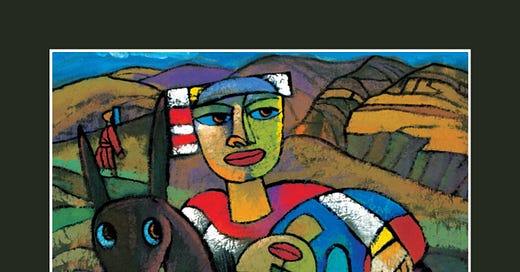The Good Samaritan, by He Qi
He Qi’s “Good Samaritan” depicts a key moment in the parable — the moment when the Samaritan loads the Jewish victim of a robbery onto his donkey for transport to a nearby inn. The victim, head inverted, dazed eyes peering dully into our own, is held on the beast by the Samaritan’s hand. Perhaps the direct gaze asks us to imagine ourselves as the beneficiary of someone’s largesse. The Samaritan, himself or herself, looks off to the distance, possibly planning his course toward a place to get help. In the background we see two of the story’s “villains,” noses in the air as they go about their business after ignoring the victim as he lay naked and bleeding on the road. The donkey offers a comical and quizzical look at his master, surprised at the load he is being asked to carry.
I like this image because it keeps the story as a story. Many times in art, Jesus is substituted for the Good Samaritan. But that choice, while pious and understandable, destroys the story’s main element: it’s a stranger and hated foreigner who takes pity on the wounded man and takes him to a place of safety. The good Samaritan is one of them, a despised minority who we don’t expect to do good to the stricken man. It’s our people — the Levite and the priest — who refuse to intervene, committed to performing their religious duties — duties that would have to be put off for several days if they came into contact with a dead body. Which the robbery victim sure looked like. In the parable, Jesus makes the super-sharp point that duty to one’s neighbor supersedes duty even to God and to worship time.
That’s what makes turning Jesus — warm, good, cuddly Jesus — a terrible choice as the Good Samaritan. That character must be a stranger — to the locale (Samaria was a separate area from Judea and Galilee where first century Jews lived) as well as to the community of faith. Turning our hero, Jesus, into the Samaritan might be made from a pious impulse. But it also makes it easier for us to assume that help is for those in our in-group, not those who rub us the wrong way religiously, ethnically and nationally.
Today, as we face a seemingly insurmountable wave of belief in a Jesus who is American, capitalist and white, we need to recall that Jesus taught that God favors those who help those who are unlike us. Who don’t attend our church. Who aren’t like us in any way save being a fellow human being.
How would Jesus tell the story today? As the Good Taliban who rescued a GI wounded by an IED? As the Good BLM member, who pulled a Philly cop out of a burning cruiser? As the Good Imam, who rushed in to offer first aid after a Parisian terror attack on an anti-islamic magazine?
Who would you least expect help from?
For more of He Qi’s art, visit his gallery.



